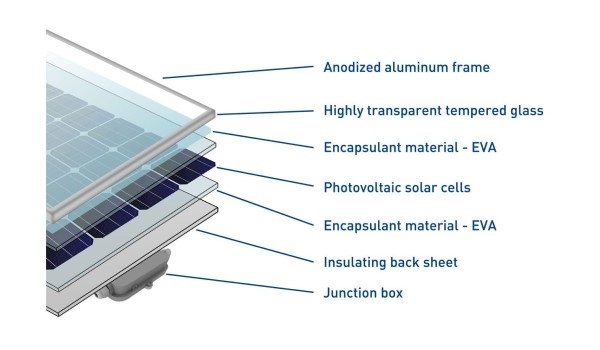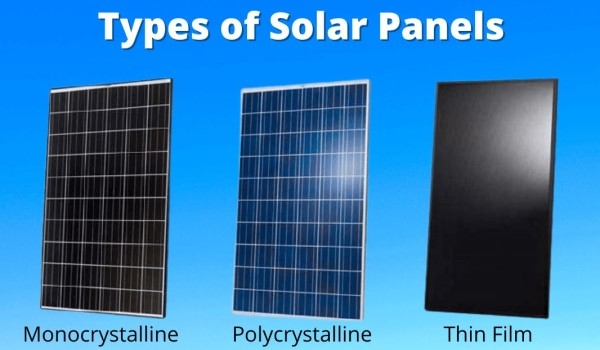A solar panel, also known as a solar module, is usually used as a unit in the solar generation. It is the core and most important part of the solar power system, and its role is to convert solar energy into electricity, or sent to the battery to be stored. The quality and cost of the solar panel will directly determine the quality and cost of the whole system. Powerhome.com will introduce the basics of solar panels so you can better understand it.
Structure and Function

- Tempered Glass: Its role is to protect the main body of power generation (such as solar cells). It is selected by the requirements: firstly, it should have high light transmittance (generally above 91%); secondly, it is treated with ultra-white toughened.
- Encapsulant Material - EVA: It is used for bonding and stabilizing tempered glass and solar cells. The quality of the transparent EVA material directly affects the life of the module. Exposed to the air, EVA is prone to aging and yellowing, which affects the light transmittance of the module and the quality of power generation. In addition to the quality of the EVA itself, the lamination process of the manufacturer is also crucial. If the bonding strength of EVA is insufficient, it will lead to its early aging and affect the life of the module.
- Photovoltaic Solar Cells: Photovoltaic solar cells are the part of the panel that is used to generate electricity; they are thin sheets of photovoltaic semiconductors that utilize sunlight to generate electricity directly. Crystalline silicon solar cells that work with photovoltaic effects are the mainstream, while thin-film cells that work with photochemical effects implement solar cells are still in their infancy.
- Insulating Back Sheet: It serves to seal, insulate and waterproof, and is generally made of aging-resistant materials such as TPT and TPE.
- Aluminum Frame: Provides some sealing and support for the solar panel.
- Junction Box: It is used to protect the whole power generation system and acts as a current transit station. If the module is short-circuited, the junction box will automatically disconnect the short-circuited string to prevent the whole system from burning. The most critical thing in the junction box is the selection of diodes, according to the different types of battery cells in the module, the corresponding diodes are also different.
Types of Solar Panels
Solar panels are generally classified according to the substrate material. If you are planning to buy solar panels, please choose the right kind according to budget and usage to avoid financial loss.
Monocrystalline Silicon Solar Panel
Monocrystalline silicon solar panel is the earliest developed and most technologically mature panel. With stable performance and high conversion efficiency, it is widely used in outdoor environments such as rooftops or fields.
It has the highest power generation efficiency of all panels, up to about 20%. However, because of the high production cost, it is currently being squeezed out of the market by polycrystalline silicon panels.
Polycrystalline Silicon Solar Panel
When making polycrystalline silicon solar panels, instead of being drawn into singles, the high-purity silicon used as a raw material is melted and poured into crystalline silicon ingots with different orientations, which are then sliced into thin sheets using a cutting machine and processed into cells.
Its conversion efficiency is lower than that of monocrystalline silicon panels, usually around 15%. However, it has developed rapidly in recent years by virtue of its lower cost, power savings and less noise, and has become the solar panel with the highest production and market share level.
Thin-film Solar Panel
These panels are made in a completely different way from monocrystalline and polycrystalline silicon panels, with a greatly simplified process, very little silicon material consumption, and lower power consumption and costs. Its thickness is less than 1% of crystalline silicon solar panels, so the area can be made very large.
Its main advantage is that it can also generate electricity under low light conditions, but the main problem is that the conversion efficiency is low, only about 7-10%, and is not stable enough, will decay over time.
Flexible Solar Panels
Flexible panels are actually a kind of thin-film panels, except that they are made of flexible materials, can be bent at will, are easy to carry, and do not require special brackets for installation, so they can be easily installed on the roof or tent roof. Not only that, it can also be customized into various sizes, shapes and colors.
The conversion efficiency of flexible panels is similar to that of thin-film panels, generally between 6-10%.

Advantages of Solar Panels
- Renewable Energy: Solar energy is an endless source of energy, and the use of solar panels can greatly reduce dependence on fossil fuels, lower greenhouse gas emissions and reduce environmental pollution.
- Economical and Practical: Solar panels have a long lifespan, typically up to 20-25 years, and are low-maintenance because they have virtually no mechanical parts, providing significant financial savings for the user.
- Reliable and Safe: Solar panels can still function in extreme weather conditions and do not involve safety hazards such as fire or explosion.
In summary, solar panels are an energy solution with multiple advantages such as environmental protection, economy and safety, which is the future trend of clean energy development.
(1).png)
(1).png)